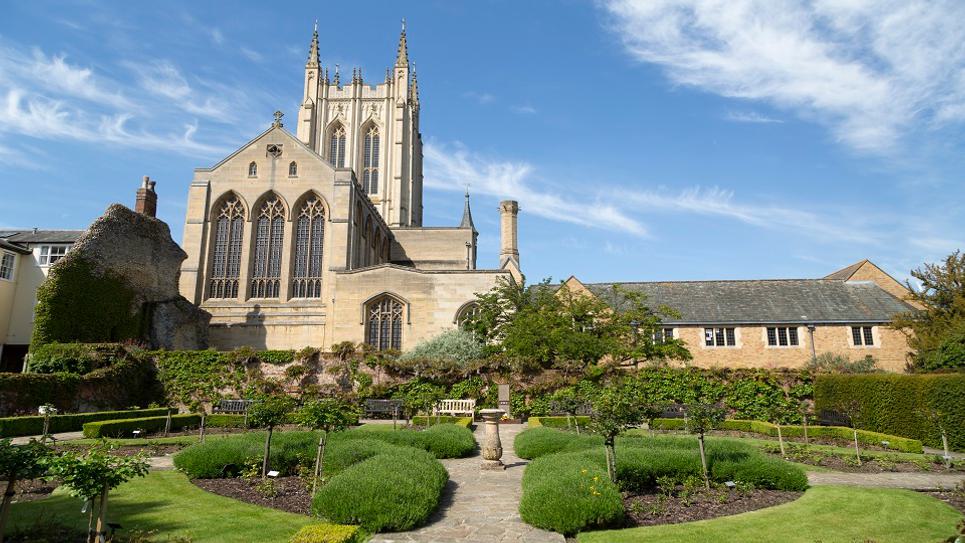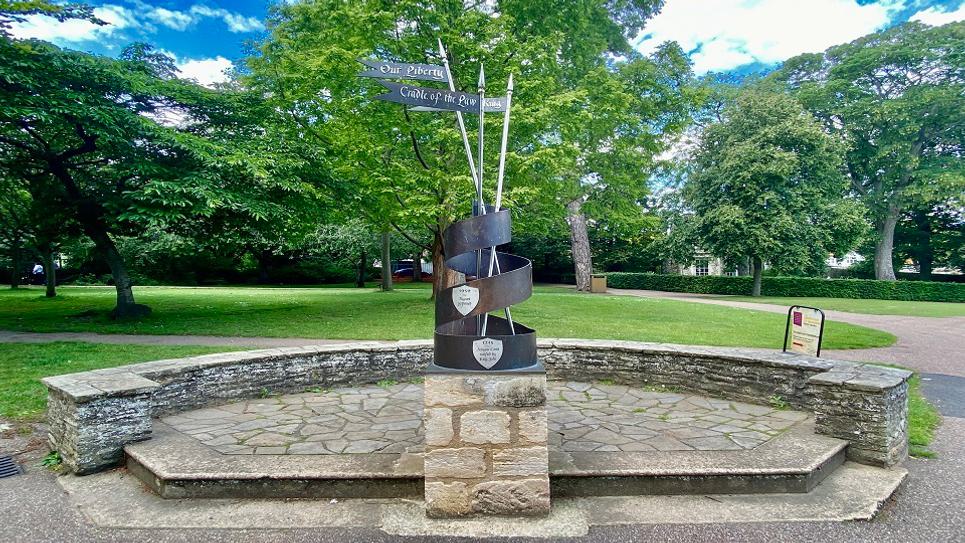
Back to Blogs
Discover
5 Things to Spot in The Abbey Gardens
Here's our top 5 things to look out for in the Abbey Gardens
1. The Legend of St Edmund Book

A wonderful oak book by Den Humphrey inscribed with the legend of St Edmund and the wolf can be found in the Abbey Gardens by the café.
2. The Wing of a 'Flying Fortress Bomber'

In the Appleby Rose Garden you'll find a bench made from the wing of an American 'Flying Fortress Bomber' and a memorial stone. Both pay tribute to the many US servicemen and women stationed in Suffolk and the 3,000 GI's who were stationed at RAF Bury St Edmunds (now Rougham Airfield).
The rose garden is named after John Appleby, an American serviceman who served with the 487th Bomb Group in Lavenham, and who wrote the book Suffolk Summer.
3. The Saint Edmund Rose

Nestled behind the Flying Fortress Bomber bench in the Appleby Rose Garden is the Saint Edmund Rose. It was planted in 2005 in commemoration of the completion of St Edmundsbury Cathedral's new Millennium Tower and the visit of HRH, Charles, Prince of Wales and Camilla, Duchess of Cornwall.
4. Our Liberty

The ‘Our Liberty’ memorial, designed by Suffolk artist Nigel Kaines, marks the meeting of the barons who came together at the Abbey of St Edmund in 1214 to sign the Charter of Liberties, the precursor to the Magna Carta.
The memorial includes the spears and banners of the barons with bronze scrollwork displaying shields carrying the important commemorative events. The design is supported on original stone from the Abbey – stones which might have been witness to the arrival of the barons all those years ago.
5. Sundial Fountain

This Victorian drinking fountain, with sundial cube on the top, was gifted to the people of Bury St Edmunds in 1871 by the 3rd Marquess of Bristol, owner of the Ickworth Estate. It is an extremely early example - quite possibly the earliest in the country - of a sundial that allowed the town clocks to be set to GMT rather than the local mean time. Originally located at the south end of The Traverse, it was moved to the Abbey Gardens in 1939. No longer a fountain it is now a beautiful planter.
Related Blogs

News
Discover Suffolk's County…
Did you know that Suffolk has a county flower? The…

News
Walks at Rougham
Rougham Estate offers 18 miles of public footpaths,…

News
Cycle the Wolf Way
Winding its way around many of the best bridleways,…

News
Perfect Picnic Spots
With stunning countryside and gardens, there are many…

News
A weekend of cycling in Bury…
Take a look at some of the best cycle routes in the…
Latest news

News
Discover Suffolk's County Flower - the Oxlip
Did you know that Suffolk has a county flower? The Oxlip only grows in some woodland areas of Suffolk, Cambridgeshire and Essex.

News
Quentin Blake ‘The Illustrated Hospital’ exhibition at Bury St Edmunds Museum
A summer exhibition of illustrations by Quentin Blake at Moyse’s Hall Museum, Bury St Edmunds presents a rare opportunity to view a large collection of pieces by one of the nation’s favourite artists.

News
Abbey Project Awarded National Lottery Heritage Fund Grant
The project aims to conserve and protect the ruins; build a visitor centre, west cloister, and network of footpaths; and use digital technology to provide exciting interpretation for all ages and…

News
Walks at Rougham
Rougham Estate offers 18 miles of public footpaths, cycling routes and permissive pathways for you to enjoy.

News
Bury St Edmunds Celebrates English Tourism Week
Bury St Edmunds MP, Jo Churchill, met representatives from the town’s attractions and tour guides involved with the town’s Masters of the Air tourism campaign at Bury St Edmunds Guildhall.

News
Tours Take Off for Masters of The Air
Tours developed by Bury St Edmunds Tour Guides and Bury St Edmunds Guildhall to tie in with the Apple TV Series Masters of The Air so popular more dates are being added.

News
International illustrator David Hughes draws largest exhibition Bury St Edmunds
The largest ever exhibition is now underway at Moyse’s Hall Museum featuring the work of internationally acclaimed illustrator David Hughes.

News
A Taste of Bury St Edmunds and Suffolk
After visiting Suffolk's foodie capital, you'll want to take it with you - here are 5 foodie treats to take home!

News
Doctor Who Stars Coming to Bury St Edmunds to Star in Sherlock Holmes Classic
Who stars Colin Baker, Terry Molloy, and Rosie Baker will star in Hound of The Baskervilles at Bury St Edmunds Theatre Royal
